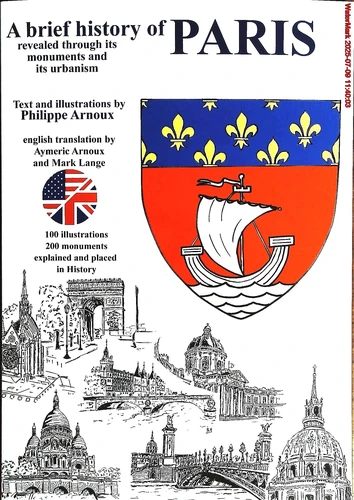A brief history of Paris. A brief history of Paris revealed through its monuments and urban planning
Par :Formats :
Actuellement indisponible
Cet article est actuellement indisponible, il ne peut pas être commandé sur notre site pour le moment. Nous vous invitons à vous inscrire à l'alerte disponibilité, vous recevrez un e-mail dès que cet ouvrage sera à nouveau disponible.
- Nombre de pages114
- PrésentationBroché
- FormatGrand Format
- Poids0.19 kg
- Dimensions1,4 cm × 2,1 cm × 0,8 cm
- ISBN978-2-9589390-1-4
- EAN9782958939014
- Date de parution10/07/2025
- ÉditeurImage et Patrimoine
Résumé
This book puts more than 230 Parisian monuments and structures into perspective with the history that gave rise to them, to help us better understand our great city, the deeper meaning of the great builders' construction projects, and the changes in styles and construction methods. It is not a guide, but rather a preliminary to one. It follows an original approach. It allows each of these witnesses to our past to tell us, very simply, how and why it came into being, and why, at a given time, it was natural for it to come into being, in a given form and under a given influence.
The text, which is intended to be clear and concise, is organised chronologically to make it easier for the reader to remember the key points. It is divided into chapters, each of which corresponds to a clearly identifiable period, or a building that corresponds to history. It forms a sort of fresco explaining the town's development. Lastly, the book is rounded off by around a hundred high-quality illustrations, produced by the author and which, perhaps better than photographs, isolate each monument to bring out its identifying silhouette and major features.
The text, which is intended to be clear and concise, is organised chronologically to make it easier for the reader to remember the key points. It is divided into chapters, each of which corresponds to a clearly identifiable period, or a building that corresponds to history. It forms a sort of fresco explaining the town's development. Lastly, the book is rounded off by around a hundred high-quality illustrations, produced by the author and which, perhaps better than photographs, isolate each monument to bring out its identifying silhouette and major features.
This book puts more than 230 Parisian monuments and structures into perspective with the history that gave rise to them, to help us better understand our great city, the deeper meaning of the great builders' construction projects, and the changes in styles and construction methods. It is not a guide, but rather a preliminary to one. It follows an original approach. It allows each of these witnesses to our past to tell us, very simply, how and why it came into being, and why, at a given time, it was natural for it to come into being, in a given form and under a given influence.
The text, which is intended to be clear and concise, is organised chronologically to make it easier for the reader to remember the key points. It is divided into chapters, each of which corresponds to a clearly identifiable period, or a building that corresponds to history. It forms a sort of fresco explaining the town's development. Lastly, the book is rounded off by around a hundred high-quality illustrations, produced by the author and which, perhaps better than photographs, isolate each monument to bring out its identifying silhouette and major features.
The text, which is intended to be clear and concise, is organised chronologically to make it easier for the reader to remember the key points. It is divided into chapters, each of which corresponds to a clearly identifiable period, or a building that corresponds to history. It forms a sort of fresco explaining the town's development. Lastly, the book is rounded off by around a hundred high-quality illustrations, produced by the author and which, perhaps better than photographs, isolate each monument to bring out its identifying silhouette and major features.



